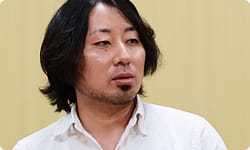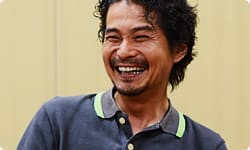Archeology
This is changing the topic, but making software for the Nintendo GameCube and Wii U is different in every way right down to the mechanics of the hardware, so you wouldn’t usually be able to convert a game for Nintendo GameCube to a game for Wii U very easily. I’d like to ask Dohta-san and Takizawa-san about that.
To start with the inspiration for development, as we were developing Wii U, we talked about how we would handle a new Zelda game for it, and as we thought about that…
You also made Zelda HD Experience.18 18. Zelda HD Experience: Revealed during E3 2011, a tech demo that showed the hardware capabilities of the Wii U console using the game world from The Legend of Zelda series.
Yeah, that was a natural evolution of Twilight Princess, while we also experimented with an illustrated taste as opposed to something that was photorealistic. Apart from that, we tinkered with taking data from previous Zelda games and simply plugging it into Wii U in HD to see what it would be like. Dohta-san really applied himself to the actual work of that.
Well, we have a wealth of images, so a programmer can do quite a lot by working at it.
That’s right. We took the various versions of Link from the Zelda HD Experience, Sword and The Wind Waker and lined them up in the same setting. We used practically the same shader19 and brought out the same shading, and Link from The Wind Waker made an overwhelmingly strong impact. He exerted some kind of unnatural pressure. 19. Shader: A graphics program for depicting light and shadow.
He wasn’t doing anything. His appearance alone stood out.
Yeah! And it looked natural. We thought that was amazing, so we set up the sea and islands from The Wind Waker, put them on the Wii U and adjusted the images. That resulted in great images with vibrant sunlight and superb contrast.
Is that what we showed in the January Nintendo Direct?
Yes.
I was doing that work, when suddenly I got an e-mail from Aonuma-san asking how long it would take to pull it off.
Aonuma-san had sprung into action. And with a question that pointed directly at the possibility of the project. (laughs)
Yeah! (laughs) To be honest, we’d secretly been calculating it, so I answered that we could do it so it can be released by fall 2013.
Aonuma-san, I suppose you were surprised they could do it in under a year.
I sure was! (laughs) If they had said it would take time, I don’t think I would have said we should do it, but under a year was extremely attractive! And I thought making an HD version of The Wind Waker had value as a way to observe how we would make the visuals for the Zelda game for Wii U.
I suppose so.
I went to Miyamoto-san right away and said, “Can we make this?” Then that talk about the Zelda cycle came up and gave us a push. And since we could do it in a short amount of time, he greenlighted development.
Well… May I interrupt? Even if the hands-on staff said they could do it and I were the producer, I’d ask for more time! (laughs)
(laughs)
The make-up of the team was a little special this time, with only a few in-house designers. When it came to things that could be done with sheer manpower like working on high-resolution textures and so forth, a lot of external designers worked with us. In other parts like the refining were basically done by Takizawa-san, Arimoto san and one more person, and we moved forward with those three being the main designers.
Three designers? Considering the deadline, even though it was a remake, correcting each bit of data by hand would be impossible.
Yeah. Actually, designers in-house that could work on this were limited since it needed to be people who were familiar with the data and direction of the original designs. We knew we weren’t able to rely on a workflow that employed a lot of people. So this time we used a special method. We devised a way to convert Nintendo GameCube data for the Wii U and to make visuals look better, while hardly laying our hands on the 3D modeling data.
Did that exist from the start?
Not at first. We had been gathering the Wii U know-how at that point from a variety of places and had been adjusting old images so they would show up as cleanly rendered images for The Wind Waker HD.
But that new method wouldn’t make all the art look better than on the Nintendo GameCube, would it?
No. Some would require special, individual attention. We wrestled with a lot of data, speculating as to what the developers’ intentions were in the original designs, and reflecting that on the Wii U shader.
Speculating about their intensions… It sounds like archeology!
(laughs)
Well, that’s exactly what Dohta-san was doing.
Yeah. Something might clearly look weird in the data but look great in the original art. Work went on for some time as I repeatedly grappled with how to recreate such things on Wii U.
One issue after the other like that came up.
The more we did, the more appeared.
This is a confession from over ten years ago, but polishing up the designer’s data wasn’t a custom that was firmly in place back then.
Yes. People had their own way of operating. Each person polished up the characters they were in charge of in their own style.
Right.
Dohta-san would say, “Takizawa-san! This is totally impossible for an environment map setting. Take a look!” I’d look at it and it would be data I had made myself! (laughs) Instead of admitting I was responsible, I’d say, “Whoa, that’s horrible! Take care of that, would you?”
(laughs)
And it’s not just the data. The Nintendo GameCube’s 3D engine was able to generate those kinds of graphics, so I went to hear what people who knew about the engine specs at the time had to say. I went all around the company and finally got Link’s eyes to move right.
The biggest problem was how, for the Nintendo GameCube at the time, they were using cel-shaded animation for visuals that couldn’t be seen anywhere else, so everyone was working in their own way by hand.
I suppose sometimes in the process of changing the numerous settings, something happens, and you just say, “Let’s run with it.”
Yeah. As a matter of fact, we found out bugs were the cause of how some of those graphics appeared on screen. So, including those things…
You recreated them?
Yes. I thought, “What in the world am I doing?”
I see. When working on the shading, you even recreated the bugs!
(laughs)
The specs were the same. There were specs no one could understand, so we had programmers analyze them and explain them.
Usually, you would handle that after designers had already verified it to some extent, but since we had so few designers, we had to carry on in a somewhat impolite way.
But doing it that way was really important for The Wind Waker HD. Adopting this process really helped us greatly.


